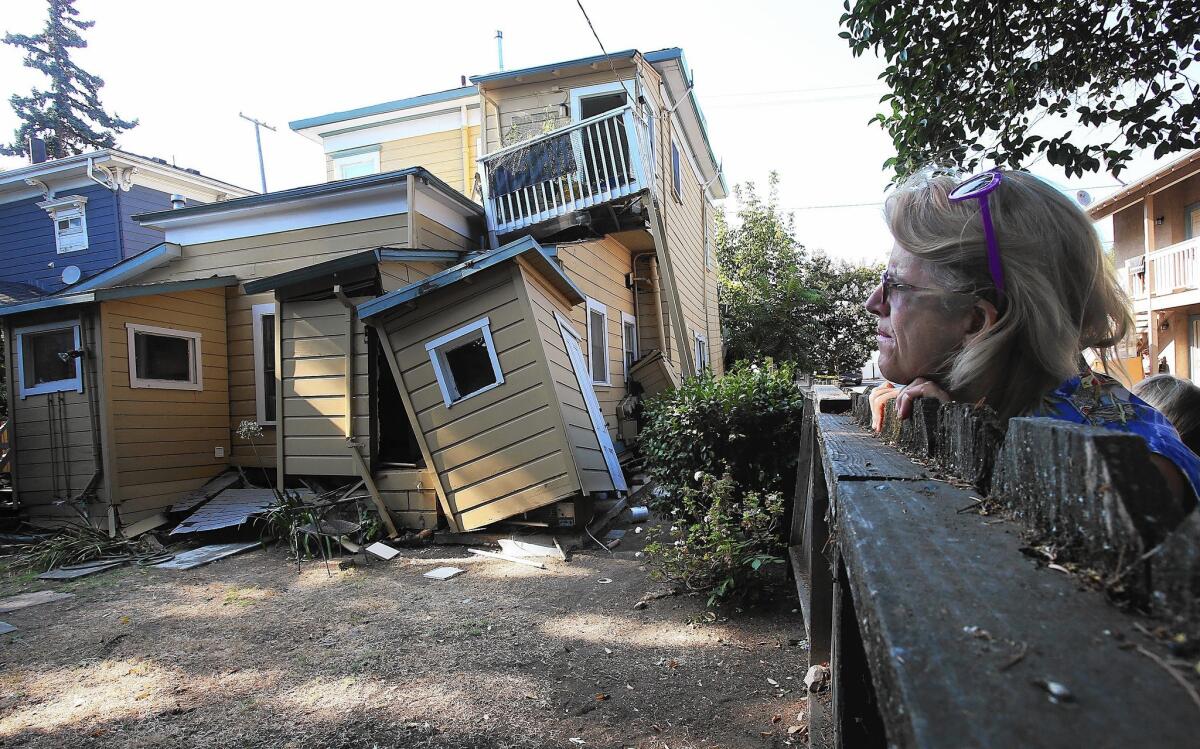Napa earthquake brought ground ruptures, highest shaking on record

- Share via
Reporting from NAPA, Calif. — The ground-shaking during the magnitude 6.0 Napa earthquake was the highest level recorded in modern times for downtown Napa, according to the U.S. Geological Survey.
The shaking was particularly bad because the force headed north from the epicenter, right into the historic downtown. Making matters worse, Napa — like Los Angeles — sits in a basin topped with soft soil, which can cause prolonged earthquake shaking.
Like a bowl of Jell-O, “once you start shaking it, it continues to shake for a long time,” said USGS research geophysicist Annemarie Baltay.
The ground motion recorded in downtown Napa came very close to the maximum level of ground shaking engineers use in their calculations when designing new buildings in that area, said Erol Kalkan, a USGS research structural engineer.
Newer buildings withstood the shaking and performed as expected, surviving with cosmetic damage, Kalkan said. But some older buildings made from brick or stone were heavily damaged, as were wood-frame homes that were knocked off their foundations.
Longtime Napa residents described the quake as more violent than what they felt during the 1989 Loma Prieta earthquake and the 2000 Napa Valley earthquake. Shaking could be felt for as long as 20 seconds, the USGS said.
“This one was very, very different,” said retiree Sherry Vattuone, 70. “My bed went up and down … like the ‘Exorcist’-type thing, and then it slid, and then all of a sudden there, it was like something took the house and went like this” — shaking her hand — “just as hard as they could.”
It wasn’t only her pasta bowls and half of her San Francisco Giants bobbleheads that were smashed in the quake: Her home leaned askew, with her basement slanted at a sickly angle from the upper floor.
She had to move into a trailer a neighbor lent her, parked outside her home, with her three dogs: Daizy, Dusty and Duncan. By late Thursday, her house had been shored up with steel beams.
Other homes were damaged by the ground rupturing beneath them, as one side of the fault moved away from the other by as much as 20 inches — leaving behind disconnected double yellow lines on Highway 12, warped rows of vineyards, and broken foundations in homes around Browns Valley Road. The zone of land ruptures stretched on for about 9 miles.
Scientists were surprised at how much ground ruptured and where it happened.
“Every earthquake — they never quite rupture exactly the way you expect them to,” said USGS research geologist Dan Ponti.
“It didn’t quite break the way we had anticipated it might.”
Faults are complicated — they tear, “like Play-Doh, in multiple pieces — not necessarily just along one sharp line,” said Baltay, the geophysicist.
The 2000 Napa Valley earthquake, a magnitude 5.2, hit further north, but did not cause ruptures on the ground’s surface.
While strong for Napa, the Aug. 24 earthquake did not produce ground shaking as intense as was felt during the 1994 Northridge earthquake. That temblor produced ground motions about 50% stronger than those recorded in Napa, Ponti said.
High-quality recordings like the one in downtown Napa provide valuable data, said David Oppenheimer, a USGS seismologist and project chief of the earthquake monitoring project.
During the 1989 Loma Prieta earthquake, for example, USGS had about 70 recordings that weren’t that high-quality. If a similar earthquake occurred in the Bay Area today, the USGS would have about 400 instruments recording ground motions at a much higher quality, Oppenheimer said. “That would give us a much greater and varied picture of the earthquake,” he said.
In Napa, city officials continue to inspect homes for signs of damage. By midweek, about 150 buildings had been red-tagged, meaning they were too dangerous to be entered, and about 1,000 more were yellow-tagged, meaning there may be limited access to the structure due to damage, said Rick Tooker, director of Napa’s Community Development Department.
Some older homes, like Victorians, saw the collapse of the cripple wall, which encloses the crawl space under the ground floor, Kalkan said. Some homeowners who had retrofitted their cripple walls appeared to ride out the quake successfully.
Kalkan said some mobile homes caught on fire due to a lack of seismic bracing, which can result in broken gas lines. Carports also suffered damage, leaving automobiles still trapped underneath collapsed overhangs.
[email protected]
Twitter: @RosannaXia
[email protected]
Twitter: @ronlin
Xia reported from Los Angeles; Lin from Napa.
More to Read
Sign up for Essential California
The most important California stories and recommendations in your inbox every morning.
You may occasionally receive promotional content from the Los Angeles Times.












